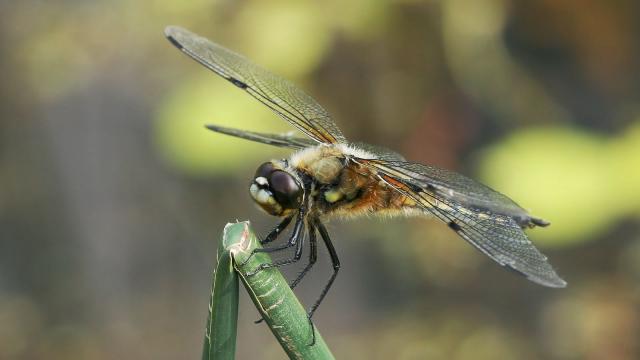Image: Wikimedia
Like a baseball player running to make a catch, dragonflies are also capable of predicting the trajectory of a moving object, typically its next meal. New research is revealing the mechanisms behind this complex cognitive task, which was once thought to be exclusive to mammals. It’s hoped that these insights will lead to innovations in robot vision.
As humans, we take it for granted that we can track and predict the trajectory an object moving through time and space. We can focus on a moving object when there’s a lot going on in the background, and even temporarily take our eyes off the object, knowing where it will be a few moments later. We can do this because our brains are equipped to make these complex calculations in real time. As a new study published in eLife points out, similar abilities are also part of the dragonfly’s cognitive arsenal.
Back in 2012, Steven Wiederman from the University of Adelaide, with the help of Lund University biologist David O’Carroll, discovered that dragonflies can do something scientists didn’t think invertebrates were capable of: “selective attention.” Dragonflies use this skill when hunting for insects, many of which take refuge in swarms. Their observations showed that dragonflies can lock onto a single target, and ignore any distractions as they dives in for the attack. Trouble is, the researchers had no idea how dragonflies were capable of knowing where moving objects would be in the future, mostly because insects weren’t thought to have the requisite brain architecture to allow for such an advanced skill.
To figure out how dragonflies were such effective hunters, Wiederman and O’Carroll decided to conduct a new study. They brought 63 male dragonflies back to their lab and immobilized them with a wax-rosin mixture. With electrodes attached to their brains, the dragonflies were shown a series of black squares intended to mimic prey. As they were shown simulated prey, the researchers watched as the activity of Small Target Motion Detectors (or STMD neurons for short) fired up in the dragonfly brains.
Instead of just following the target through time and space along a straight line (as most insects are thought to do), the STMD neurons actually worked to predict the future location of the black dots, according to the new study. These specialised neurons increased their activity in a tiny “focus” area just in front of the moving object being tracked; individual neurons were more sensitive to movements just ahead of the black dot’s current position. Also, when the black dot suddenly disappeared (as a target might do when, say, it flies behind a tree), the dragonfly brain still worked to predict where the dot was most likely to reappear. Insects without this trajectory-crunching capacity would just give up the chase once an object disappears from its vision.
“Insects and mammals last shared a common ancestor more than 500 million years ago, and, in many respects, mammalian brains are substantially more complex than insect brains,” conclude the authors in the study. “Nevertheless, [our findings] show that the insect brain can perform visual tasks that were previously associated only with mammals.”
This is an exciting finding, and not just because of what it tells us about insectoid brains. In the coming years, scientists can use these insights to develop safer and more capable autonomous robots, whether they be self-driving vehicles (which, like dragonflies, are moving objects that need to predict the trajectory of other moving objects), or flying robots used for reconnaissance purposes or as artificial pollinators.
Indeed, there’s no need to reinvent the wheel; nature has already performed plenty of research and development on our behalf over the millennia.
[eLife]
